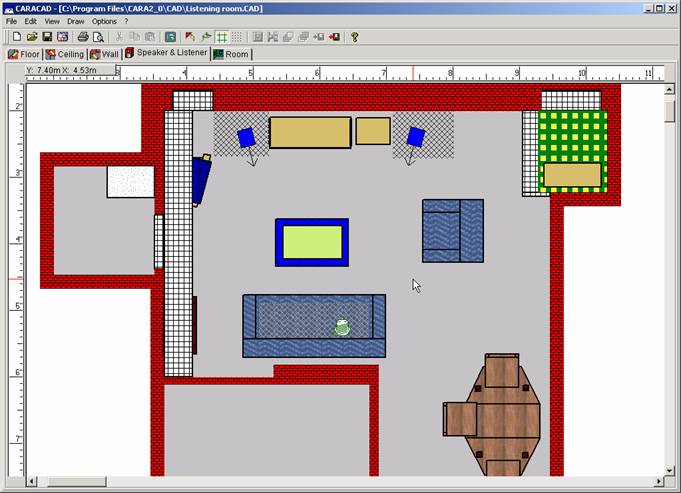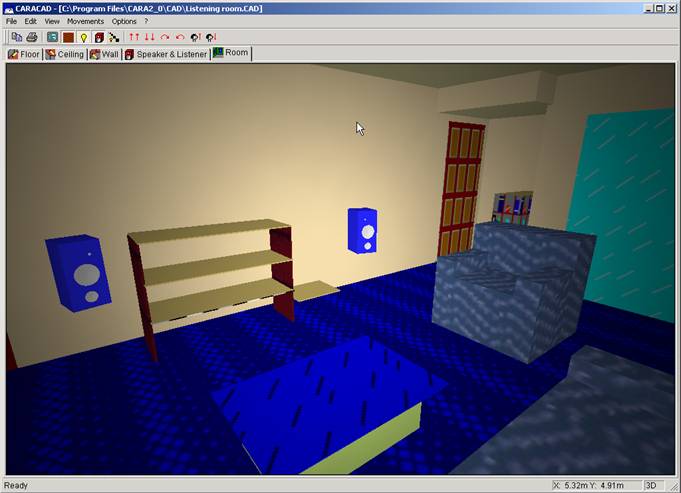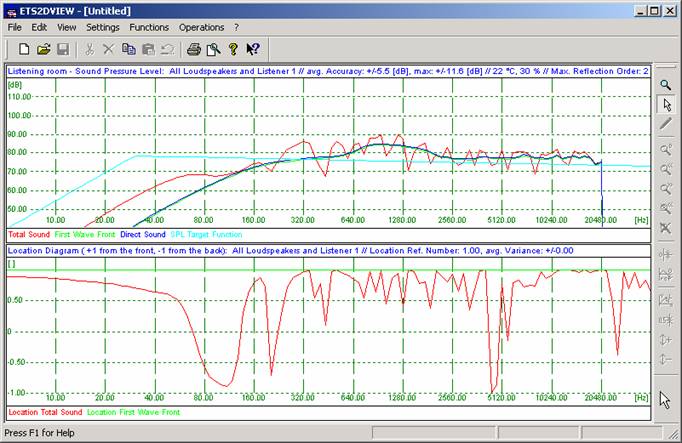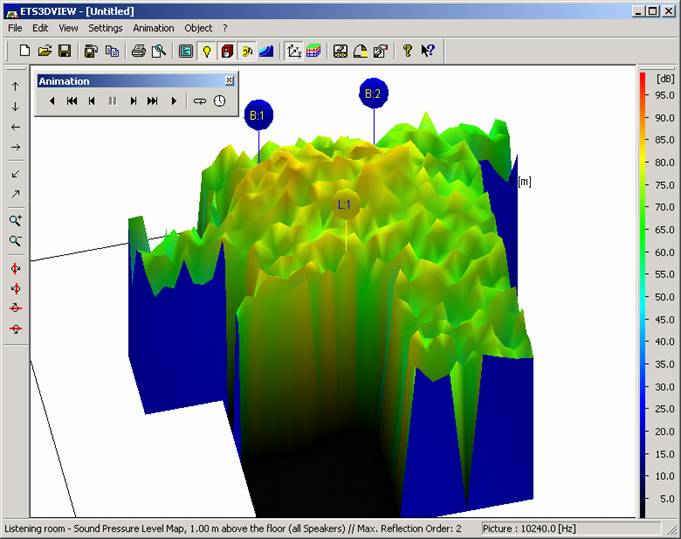|
You are reading the older HTML site Positive Feedback ISSUE 8 august/september 2003
CARA (Computer Aided Room Acoustics) Room Acoustics software
Studio professionals strive to achieve very controlled, repeatable and consistent technical results in their recordings. There are even those producers that rise above the anonymous name on the back of the record sleeve by having "a sound" to their work. Through careful adjustment with playback calibration tapes, electronic tone generators, oscilloscopes and other test equipment, engineers can achieve consistent sounding results from their recordings, minimize generational loss to within tolerable levels and can even punch into and out of record in the middle of analog recordings. There is just no substitute for having the right tools for the job. Unfortunately most of these tools are too expensive and complicated to be practical for home use. At home, our listening room is the most important and complicated variable in our system. Whether you realize it or not, your room makes a greater impact on the overall sound of your system than any piece of equipment you'll ever buy. Unfortunately audiophiles often underestimate or overlook completely the importance of their room. CARA (Computer Aided Room Acoustics) Room Acoustics software attempts to use computer modeling to replace those expensive, professional tools of the trade the professionals use. The personal computer, and its ever increasing processing power, has given home users the ability to approximate the modeling processes needed to estimate room acoustics without all the expensive hardware. But how well could a sound analyzation tool work if it doesn't have a microphone listening device to test tones in a room? I've been using The Listening Room from Sitting Duck Software for many years to evaluate speaker placement in new installations. While not a perfect solution by any stretch, it does seem to always give me a good starting placement for speakers to begin my listening in a new room or setup. Final speaker and listener positions are then tweaked by ear but usually aren't too far from the position suggested by the software. But The Listening Room (later known as Visual Ears Loudspeaker Placement Program from KB Acoustics) has some serious limitations. It cannot evaluate irregular shaped rooms or room anomalies such as doorways; it does not consider different construction surfaces, cannot account for any furnishings in the room and would only work with speakers using dynamic drivers. CARA (Computer Aided Room Acoustics) Room Acoustics software addresses these shortcomings… and more. CARA is really a suite of smaller programs designed around each task required for the room analyzation process:
Despite the program's complexity, the CARA software installs quickly and simply, takes up very little hard drive real estate and ran flawlessly for me under both Microsoft's Windows 98 and Windows 2000 Professional operating systems. The CARA suite works by searching for the optimum speaker placement and listening positions once room dimension and interior furnishing details have been input. Room design is handled by the CARA CAD module (Figure 1). Now for those of you that like to just load software onto your computer and dive right in, I bid you adieu and wish you luck. A word of advice… take some time to read the help files. You will save yourself a lot of time later. Once you get the hang of some of the design idiosyncrasies inherent in the software, things should go very smoothly. The CAD program uses custom grid points (all metric, you will have to convert your American/English measurements) to layout the room dimensions. Building elements then snap to the grid points making design easy and extremely accurate. Doorways, vaulted ceilings, overhangs and even rounded or irregular facades can all be accommodated. Choose different surfaces from a menu to define the absorption/reflection characteristics of the room elements you have created. Once you have defined the perimeter of your room, you can fill the room with furniture choosing basic pieces from a menu, modifying pieces from the menu or by creating your own from scratch, depending on your needs.
Figure 1 CARA CAD room layout view
Your room design can be as simple or complex as you want. If like me you have an anal retentive side, you may choose to spend as much time as is necessary to make the model match your room almost exactly. I started by designing my entire room, every nook, cranny, anomaly and piece of furniture. This takes quite a bit of time but remember the garbage in garbage out rule. I found it could be difficult to know exactly which surfaces to choose from CARA's built-in list of choices. If you did not build your home for example, you may not know which of the eleven sheet rock surfaces offered by Cara most closely matches your actual building materials. Some surfaces such as window blinds may not even be available from the dropdown menu. You can modify or create your own surfaces by defining its absorption or reflection properties at 118 different frequency points… very snazzy but if I had the equipment to measure that, I wouldn't need Cara in the first place. Finally, you will need to define your listening area and speakers. CARA provides a list of pre-programmed speakers in its database. Most are European models due the software's German lineage or geared toward the professional installation. You will likely need to "build" your speakers with Cara's built-in loudspeaker editor using information about crossover, frequency response, dispersion, etc. from your loudspeakers manufacturer. Finally, you will be asked to define the available space in which CARA can rearrange the speakers' and listeners' (check out the stylish comb-over on the listener icon! (Figure 1)) positions to find the best frequency response. This keeps Cara from placing speakers beyond the boundaries which are feasible for real world placement. Switching to CARA's 3-D (Figure 2) view mode allows you to "walk" around your virtual room. 3-D view mode lets you see that your digital room resembles your physical room as closely as possible. I had a few errors in my design that were easily visible from the 3-D view. A few more minutes in the CAD module for corrections and all was well with the virtual world again.
Figure 2 CARA CAD 3-D room view
Once your room design is complete, it is time to do some calculations with the CARA CALC room calculations module. I first ran the sound-field calculations for my current room setup and saved the results so that I had a basis with which to compare my optimized results later. Figure 3 shows a frequency plot as estimated from the listening position. Notice the significant deviations from flat response here. This curve might confirm a frequency bump you think you have been hearing in your system or alert you to some anomaly that you overlooked until seeing it graphically. Spikes or dips in the graph may be caused by the frequency response of your speakers, a crossover point, or hopefully so you can address the issue, by something in your room. The next step is to run CARA's positional calculations to find the optimal seating and speaker positions for your room. Once it starts processing, CARA will keep moving your speakers and listener positions virtually within the areas defined in your room layout. In each new position it tries, CARA calculates sound reflections from your room boundaries and furniture and then compares the new estimated frequency curve to the original to see if the results are nearer or further from flat. Once an improved position is identified, CARA tries another position to look for further improvement. I ran the CARA suite on a 1Ghz Athlon machine with 512mb RAM yet due to the complexity of the calculations, the evaluation step can take considerable computing time. If not interrupted, the optimization process will run 10,000 trials. CARA's help files suggest running your tests calculating at least 10 reflections. If you don't own a Cray supercomputer this will be a monumental task as calculation times increase logarithmically with the number of reflections calculated. For example, analyzing three reflections in my room took about 2 seconds for each trial. Four reflections required 1m 15s per trial and five reflections needed 1h 55m per trial calculation. Keep in mind that the manual suggests running at least 100-500 trials for accurate results! The calculation process cannot be stopped and restarted so you will either have to allocate enough computer time or simplify your model by reducing the number of elements in your room (i.e. Furniture).
Figure 3 CARA CALC amplitude frequency response and location results
When processing is finished, CARA suggests a new, optimized position for speakers and listener according to its results. Accompanying the new suggested positions will be the estimated results in SPL throughout the frequency spectrum for these new positions and their deviation from the ideal. These results can then be compared to those taken before optimization. Hopefully CARA will have smoothed out your frequency response considerably by moving only your speakers and listening position. If not, you can use the positional sound field (Figure 4) results to make assumptions about what piece in your room is causing the bump or dip in your response curve. Just move through the animation to the frequency where the bump or peak resides and CARA will show you a topographic map of your room with peaks and valleys representing volume in decibels. From this you will be able to see the likely cause of the aberration.
Figure 4 CARA CALC positional sound field results
Once you have an idea of what may be causing your troubles, you can attempt changes to repair the problem… virtually. You may begin by moving furniture, adding/removing elements such as draperies or carpeting, or even moving walls before rerunning the calculations. This gives you a preview of the likely acoustic results before making costly and time-consuming real world room modifications. The CARA software offers no option for optimal positioning while maintaining symmetry between speakers and listener. CARA models each speaker individually to find its optimal position within the area available. In an odd shaped room, you may get optimized results suggesting that speakers be placed in an asymmetrical arrangement. Also, CARA will almost always find the best position with the speakers pointing directly at the listener so the maximum volume of direct rather than reflected sound reaches the listener. CARA is indeed finding the position that will return the flattest frequency response, but these setups are often not good for imaging. In these cases the software will require a bit of human intervention. I've lived with my ProAcs in my current listening room for many years. I've swept tones using SPL meters and even spent a weekend with a pink noise generator and an Ivie spectrum analyzer. I know that there are a few problems in my room that I've not been able to overcome so I didn't expect any miracles from CARA. Armed with the optimized results for my room from the CARA program, I arranged my ProAcs and listening position as ordered. Placing my ProAcs in the optimized positioning suggested by CARA did indeed reveal a flatter response. Gone was a slight bump in the lower midrange, likely a byproduct of a bass node in one corner. Also gone was a tizziness in the high end likely caused by room reflections. I had not even recognized this high-end anomaly until I heard it removed. I didn't move the speakers much at all. Cara asked me to move one speaker about six inches back, one speaker twelve inches wider, and the listening position six inches forward. Very small changes in your room can make very noticeable differences in sound and CARA has the power to model even these small differences. If you are like me, with your listening room pulling double duty as a living room leaving only a few feet this way or that to move your speakers, good old listening experimentation may be a better use of your time than the CARA software. However, for those with the purpose and inclination, CARA is a very powerful tool. The value of its results is dependent on the accuracy of your input data and your ability to interpret the results. The biggest problem with the CARA software is not CARA's problem at all. You must be able to make changes to your room. Although it might be fun to find out that a different wallboard material would make your transistor radio sound like nirvana, you have to be willing and able to make the changes. Willing to make those changes or about to build your dream room from scratch? CARA is the most accurate and most cost effective modeling software I have come across. web address: http://www.cara.de/
|




